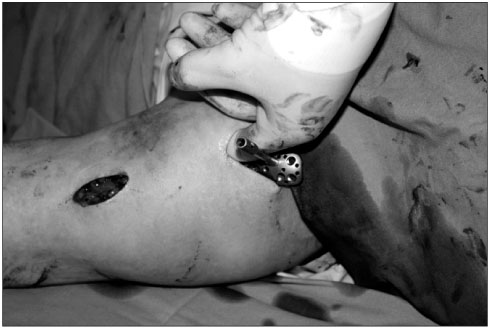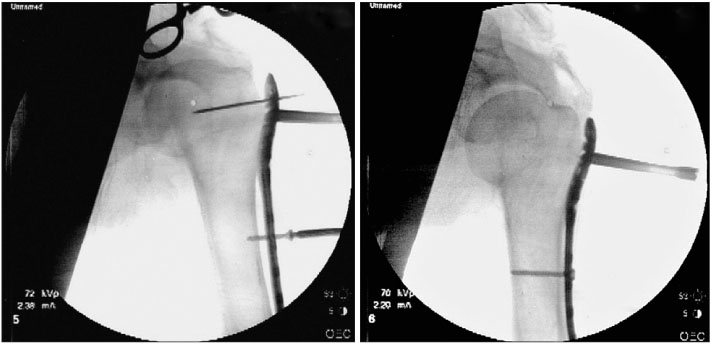J Korean Orthop Assoc.
2010 Dec;45(6):448-455. 10.4055/jkoa.2010.45.6.448.
Minimally Invasive Plate Osteosynthesis of Proximal, Middle and Distal Humerus Fractures
- Affiliations
-
- 1Department of Orthopaedic Surgery, Ewha Womans University College of Medicine, Korea.
- 2Department of Orthopaedic Surgery, National Medical Center, Seoul, Korea. shs8383@hanmail.net
- KMID: 2185492
- DOI: http://doi.org/10.4055/jkoa.2010.45.6.448
Abstract
- PURPOSE
The purpose of this study is to evaluate the clinical and radiological outcomes of proximal, middle and distal third humeral fractures treated with the minimally invasive plate osteosynthesis (MIPO).
MATERIALS AND METHODS
Thirty-one patients with the proximal, middle or distal third humeral fractures underwent MIPO. There were 12 men and 19 women with an average age of 46.7 years. The radiological outcomes of bony union and anatomical reduction were evaluated. The clinical outcomes were assessed by measuring the range of shoulder and elbow motion, UCLA scores, KSS sores and the postoperative complications.
RESULTS
Fracture union was obtained in all patients at an average of 18.4 weeks. According to the UCLA scores, 9 were excellent and 3 were good for the proximal humeral fractures. For the middle and distal third fractures, UCLA scoring system showed excellent results in 15 cases and good results in 4 cases. The average KSS scores of proximal and shaft fracture were 92.5 and 98.6, respectively. Complications developed in 3 patients: one had radial nerve palsy, one had a fracture adjacent to the plate distally, and one had a rotational deformity.
CONCLUSION
MIPO for proximal, middle and distal third humeral fractures provided satisfactory clinical and radiological outcomes considering high union rate and minor complications.
MeSH Terms
Figure
Cited by 2 articles
-
Minimally Invasive Plate Osteosynthesis for Humeral Proximal or Distal Shaft Fractures Using a 3.5/5.0 Metaphyseal Locking Plate
Hyoung Keun Oh, Suk Kyu Choo, Jung Il Lee, Dong Hyun Seo
J Korean Fract Soc. 2012;25(4):305-309. doi: 10.12671/jkfs.2012.25.4.305.Minimally Invasive Plate Osteosynthesis for Humeral Proximal or Distal Shaft Fractures Using a 3.5/5.0 Metaphyseal Locking Plate
Hyoung Keun Oh, Suk Kyu Choo, Jung Il Lee, Dong Hyun Seo
J Korean Fract Soc. 2012;25(4):305-309. doi: 10.12671/jkfs.2012.25.4.305.
Reference
-
1. Volgas DA, Stannard JP, Alonso JE. Nonunions of the humerus. Clin Orthop Relat Res. 2004. 419:46–50.
Article2. Mills HJ, Horne G. Fractures of the proximal humerus in adults. J Trauma. 1985. 25:801–805.
Article3. Sarmiento A, Kinman PB, Galvin EG, Schmitt RH, Phillips JG. Functional bracing of fractures of the shaft of the humerus. J Bone Joint Surg Am. 1977. 59:596–601.
Article4. Flinkkilä T, Hyvönen P, Lakovaara M, Linden T, Ristiniemi J, Hämäläinen M. Intramedullary nailing of humeral shaft fractures. A retrospective study of 126 cases. Acta Orthop Scand. 1999. 70:133–136.
Article5. Rommens PM, Blum J, Runkel M. Retrograde nailing of humeral shaft fractures. Clin Orthop Relat Res. 1998. 350:26–39.
Article6. Apivatthakakul T, Patiyasikan S, Luevitoonvechkit S. Danger zone for locking screw placement in minimally invasive plate osteosynthesis (MIPO) of humeral shaft fractures: a cadaveric study. Injury. 2010. 41:169–172.
Article7. Zhiquan A, Bingfang Z, Yeming W, Chi Z, Peiyan H. Minimally invasive plating osteosynthesis (MIPO) of middle and distal third humeral shaft fractures. J Orthop Trauma. 2007. 21:628–633.
Article8. Livani B, Belangero WD. Bridging plate osteosynthesis of humeral shaft fractures. Injury. 2004. 35:587–595.
Article9. Ji F, Tong D, Tang H, et al. Minimally invasive percutaneous plate osteosynthesis (MIPPO) technique applied in the treatment of humeral shaft distal fractures through a lateral approach. Int Orthop. 2009. 33:543–547.
Article10. Paavolainen P, Björkenheim JM, Slätis P, Paukku P. Operative treatment of severe proximal humeral fractures. Acta Orthop Scand. 1983. 54:374–379.
Article11. Shin SI, Song KW, Lee JY, et al. Treatment of two- and three-part fracture of proximal humerus using LCP. J Korean Shoulder Elbow Soc. 2007. 10:204–211.
Article12. Vander Griend R, Tomasin J, Ward EF. Open reduction and internal fixation of humeral shaft fractures. Results using AO plating techniques. J Bone Joint Surg Am. 1986. 68:430–433.
Article13. Farouk O, Krettek C, Miclau T, Schandelmaier P, Guy P, Tscherne H. Minimally invasive plate osteosynthesis and vascularity: preliminary results of a cadaver injection study. Injury. 1997. 28:Suppl 1. A7–A12.
Article14. Rouleau DM, Laflamme GY, Berry GK, Harvey EJ, Delisle J, Girard J. Proximal humerus fractures treated by percutaneous locking plate internal fixation. Orthop Traumatol Surg Res. 2009. 95:56–62.15. Apivatthakakul T, Arpornchayanon O, Bavornratanavech S. Minimally invasive plate osteosynthesis (MIPO) of the humeral shaft fracture. Is it possible? A cadaveric study and preliminary report. Injury. 2005. 36:530–538.16. Kobayashi M, Watanabe Y, Matsushita T. Early full range of shoulder and elbow motion is possible after minimally invasive plate osteosynthesis for humeral shaft fractures. J Orthop Trauma. 2010. 24:212–216.
Article
- Full Text Links
- Actions
-
Cited
- CITED
-
- Close
- Share
- Similar articles
-
- Minimally Invasive Plate Osteosynthesis for Humeral Proximal or Distal Shaft Fractures Using a 3.5/5.0 Metaphyseal Locking Plate
- Minimally Invasive Percutaneous Plate Stabilization Using a Medial Locking Plate for Proximal Tibial Fractures: Technical Note
- Comparison of Results of Minimally Invasive Plate Osteosynthesis according to Types of Locking Plate in Distal Femoral Fractures
- Axial Malalignment after Minimally Invasive Plate Osteosynthesis in Distal Femur Fractures with Metaphyseal Comminution
- Minimally Invasive Percutaneous Plate Osteosynthesis Using Periarticular Plate for Distal Tibial Fractures






